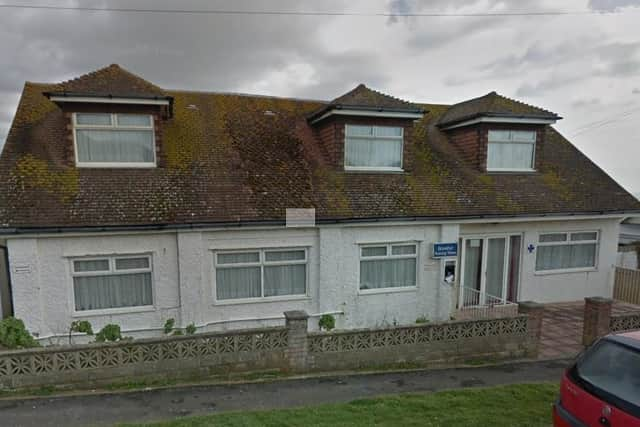Peacehaven halfway house for released prisoners fails to win support
This article contains affiliate links. We may earn a small commission on items purchased through this article, but that does not affect our editorial judgement.
and live on Freeview channel 276
On Wednesday (March 9), Lewes District Council’s planning committee considered a pair of applications connected to a former care home at 1 Bramber Avenue which when put together would have allowed it to be converted into supported accommodation for people leaving custody.
This plan had proven to be highly controversial among residents of Bramber Avenue and the surrounding area. Among those to raise concerns was Elizabeth Venn, who runs Fourways, a House in Multiple Occupation (HMO) which would be the proposed facility’s immediate neighbour.
Advertisement
Hide AdAdvertisement
Hide AdSpeaking at the meeting, Ms Venn said: “We all frequently see on the news about the vulnerable homeless families, women who are subjected to domestic violence and people who stay in hospital because they have nowhere to go. These are the people that I am proud to say we house at Fourways.


“These vulnerable people come to us at possibly the worst time in their lives. We don’t just provide accommodation, we also provide safety and the security they need, the opportunity to heal and move on with their lives.
“I have no doubt that ex-convicts also need a place to heal and move on with their lives, but neither 1 Bramble Avenue nor anywhere in Peacehaven — which does not have a police station — is suitable for a facility housing people just released from prison.”
Despite strong support for this argument, planning officers warned that the committee was on shaky grounds for refusal, due to an unusual set of circumstances with how the proposals had come forward.
Advertisement
Hide AdAdvertisement
Hide AdThe applications sought permission for two things: one to make various alterations to the existing building and its surroundings; and another to remove conditions from a previous planning consent which prevent anyone apart from elderly people from living within it.
It was the removal of the condition which posed the problem.
Under national legislation, buildings have ‘use classes’ which determine what activities a building can or cannot be utilised for. A family home for example is classed as a C4 property, while a hotel would be a C1 property.
To move between these categories — for example converting a family home into a hotel — the owner would need to secure planning permission for a ‘change of use’ .
Advertisement
Hide AdAdvertisement
Hide AdHowever, both a care home and the sort of facility proposed are C2 class properties, meaning that from a planning perspective the activity is the same. Therefore no planning permission is necessary.
In short, the only thing preventing the building from being used as supported accommodation as things stand is the condition.
Officers warned that the condition — which was applied as part of the original 1968 planning application to convert the building from a family home into a care home — would not stand up to a challenge under modern standards.
On top of that, the application was only seeking permission to remove this condition. As a result, officers said, arguments around the suitability of the proposed facility should not come into the committee’s decision-making.
Advertisement
Hide AdAdvertisement
Hide AdThey were only supposed to consider the condition — considered to be out-of-date — itself.
This point was reiterated by Rupert Nesbitt-Day, a representative of applicant Seetec Limited, who argued the intended use was not something which should be considered by the committee. Despite this, he went on to speak of the need for such facilities and how they operate.
He said: “Half a mile from here stands Lewes Prison. Behind its walls there are around 700 men serving their sentences. Most will be released and return home, like 4,000 other prisoners released monthly in England and Wales.
“The majority do not need enhanced support in the community, but some will, even after they finish their sentence and have demonstrated suitability for release. These people will return to our communities and it is in all of our interests to give them the best chance of reintegrating successfully.”
Advertisement
Hide AdAdvertisement
Hide AdHe added: “We hear the anxieties voiced by those who would be our near neighbours and recognise that any advantages feel remote if you are concerned about who may be living next door to you.
“That is why we have offered meetings, made arrangements and amendments to our property plans following feedback from neighbours and published details of how we intend to manage the centre.”
Despite this advice, the committee ultimately decided on a majority vote not to approve the removal of the condition, effectively preventing (or at least stalling) the planned conversion.
However, it went on to approve the second application, which covered the actual building works. These included a number of alterations to the building, such as installation of new doors and windows.
Advertisement
Hide AdAdvertisement
Hide AdThis second application had also set out plans to increase the number of bedrooms in the building from 21 to 27, but as internal alterations this part of the proposal did not require planning permission.
For further information on the applications see references LW/21/0803 and LW/21/0804 on the Lewes District Council website.
For the latest breaking news where you live in Sussex, follow us on Twitter @Sussex_World and like us on Facebook @SussexWorldUK
